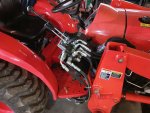I am purchasing a universal electric rear remote valve kit (3 spool) from Summit Hydraulics for my 2024 L4802. No one that I can find, has a kit for L4802 yet so I’m going to try to install this universal kit on my own with limited experience dealing with hydraulics.
My first thought is the easiest way to plumb the valve kit into the hydraulics is through the rear loop quick couplers normally used for the backhoe. My thought is when I’ll be using the rear valve kit for rear implements, the backhoe will be removed and those hydraulic lines will be connected to each other and unused. Why not attach hoses to the valve kit pressure line and return line, with corresponding quick couplers to attach to the rear loop quick couplers?
When I attach the backhoe I can disconnect the valve kit from the rear loop and then the rear loop is again attached to the backhoe. My brain thinks this is a simpler faster solution. Or am I wrong and don’t attempt it this way, just plumb it in another way?
My first thought is the easiest way to plumb the valve kit into the hydraulics is through the rear loop quick couplers normally used for the backhoe. My thought is when I’ll be using the rear valve kit for rear implements, the backhoe will be removed and those hydraulic lines will be connected to each other and unused. Why not attach hoses to the valve kit pressure line and return line, with corresponding quick couplers to attach to the rear loop quick couplers?
When I attach the backhoe I can disconnect the valve kit from the rear loop and then the rear loop is again attached to the backhoe. My brain thinks this is a simpler faster solution. Or am I wrong and don’t attempt it this way, just plumb it in another way?


